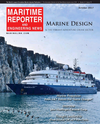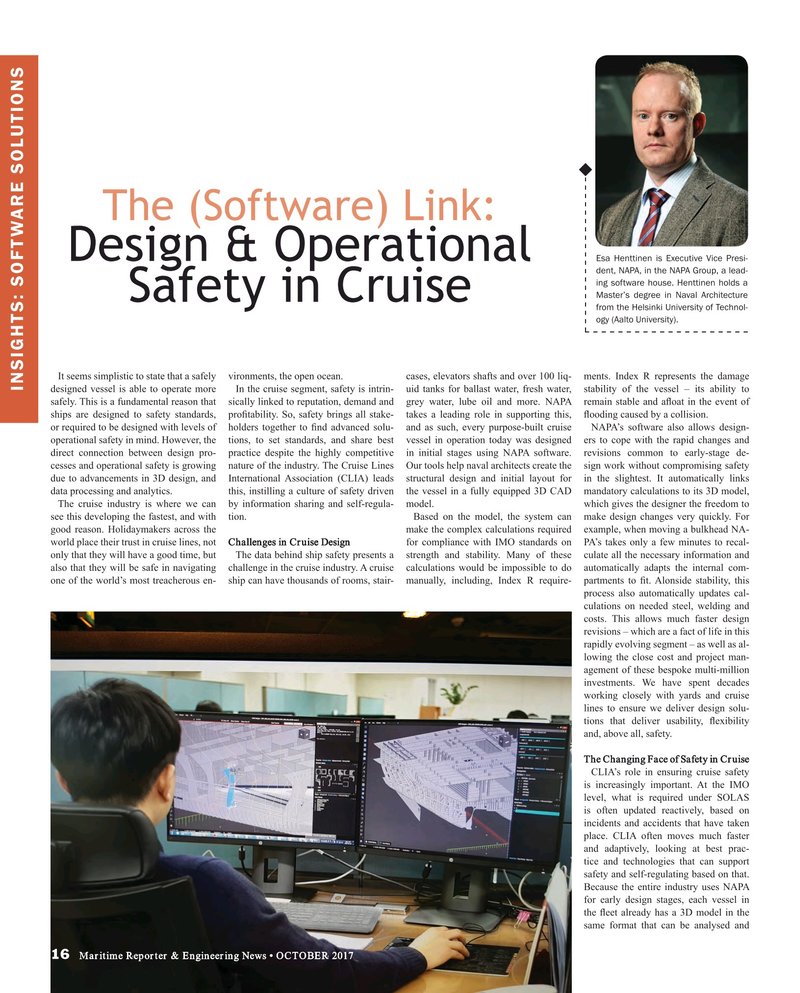
Page 16: of Maritime Reporter Magazine (October 2017)
The Marine Design Annual
Read this page in Pdf, Flash or Html5 edition of October 2017 Maritime Reporter Magazine
The (Software) Link:
Design & Operational
Esa Henttinen is Executive Vice Presi- dent, NAPA, in the NAPA Group, a lead- ing software house. Henttinen holds a
Master’s degree in Naval Architecture
Safety in Cruise from the Helsinki University of Technol- ogy (Aalto University).
It seems simplistic to state that a safely vironments, the open ocean. cases, elevators shafts and over 100 liq- ments. Index R represents the damage
INSIGHTS: SOFTWARE SOLUTIONS designed vessel is able to operate more In the cruise segment, safety is intrin- uid tanks for ballast water, fresh water, stability of the vessel – its ability to safely. This is a fundamental reason that sically linked to reputation, demand and grey water, lube oil and more. NAPA remain stable and a? oat in the event of ships are designed to safety standards, pro? tability. So, safety brings all stake- takes a leading role in supporting this, ? ooding caused by a collision. or required to be designed with levels of holders together to ? nd advanced solu- and as such, every purpose-built cruise NAPA’s software also allows design- operational safety in mind. However, the tions, to set standards, and share best vessel in operation today was designed ers to cope with the rapid changes and direct connection between design pro- practice despite the highly competitive in initial stages using NAPA software. revisions common to early-stage de- cesses and operational safety is growing nature of the industry. The Cruise Lines Our tools help naval architects create the sign work without compromising safety due to advancements in 3D design, and International Association (CLIA) leads structural design and initial layout for in the slightest. It automatically links data processing and analytics. this, instilling a culture of safety driven the vessel in a fully equipped 3D CAD mandatory calculations to its 3D model,
The cruise industry is where we can by information sharing and self-regula- model. which gives the designer the freedom to see this developing the fastest, and with tion. Based on the model, the system can make design changes very quickly. For good reason. Holidaymakers across the make the complex calculations required example, when moving a bulkhead NA- world place their trust in cruise lines, not Challenges in Cruise Design for compliance with IMO standards on PA’s takes only a few minutes to recal- only that they will have a good time, but The data behind ship safety presents a strength and stability. Many of these culate all the necessary information and also that they will be safe in navigating challenge in the cruise industry. A cruise calculations would be impossible to do automatically adapts the internal com- one of the world’s most treacherous en- ship can have thousands of rooms, stair- manually, including, Index R require- partments to ? t. Alonside stability, this process also automatically updates cal- culations on needed steel, welding and costs. This allows much faster design revisions – which are a fact of life in this rapidly evolving segment – as well as al- lowing the close cost and project man- agement of these bespoke multi-million investments. We have spent decades working closely with yards and cruise lines to ensure we deliver design solu- tions that deliver usability, ? exibility and, above all, safety.
The Changing Face of Safety in Cruise
CLIA’s role in ensuring cruise safety is increasingly important. At the IMO level, what is required under SOLAS is often updated reactively, based on incidents and accidents that have taken place. CLIA often moves much faster and adaptively, looking at best prac- tice and technologies that can support safety and self-regulating based on that.
Because the entire industry uses NAPA for early design stages, each vessel in the ? eet already has a 3D model in the same format that can be analysed and 16 Maritime Reporter & Engineering News • OCTOBER 2017
MR #10 (10-17).indd 16 MR #10 (10-17).indd 16 10/4/2017 9:16:11 AM10/4/2017 9:16:11 AM

 15
15

 17
17
